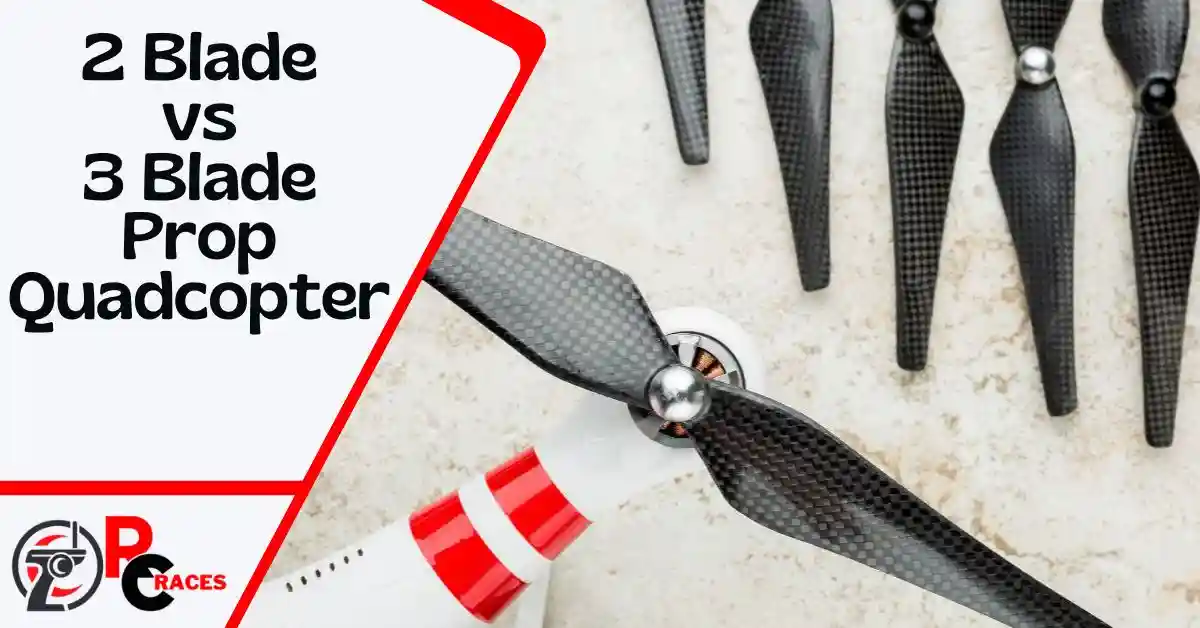Choosing a drone can be really confusing sometimes. We totally understand that. Because of this reason, many people often wonder what blade quadcopter to get.
What are the differences between 2 blade vs 3 blade prop quadcopter?
The biggest differences between 2-blade and 3-blade quadcopters are speed, maneuver, and stability. While 2-blade drones are faster, they’re less stable and hard to maneuver. 3-blade quadcopters can be less efficient. But, it offers higher thrust and grip. Also, 2-blade drones are significantly cheaper.
Anyways, these were nothing but just brief differences. Without a doubt, there’s a lot more we couldn’t fit and they require further elaboration.
To know more about blades and their effects on quadcopters, keep reading till the end.
2 Blade Quadcopter vs 3 Blade Quadcopter: Notable Differences
You’ll come across many 2-blade vs 3-blade quadcopter debates on different forums. To be frank, there are some major advantages to both types of quadcopters.
To pick a side, you’ll need to understand what’s going to help your cause. Some people prefer speed over stability. In contrast, some people want less noise or easier tracking.
Comparing XT30 with XT60 is also quite similar. They’re beneficial for quadcopters but only in certain fields.
Because of that, we’ve compared both types of quadcopters in separate categories. Since there are many factors, the comparison can get really messy.
For that reason, we’ve made you small chart first-
| Features | 2 Blade Quadcopter | 3 Blade Quadcopter |
| Price Point | Cheaper | Expensive |
| Speed | Faster | Slightly Slower |
| Maneuverability | Harder | Easier |
| Height Range | Moderate | Higher |
| Thrust Power | Less | More |
| Grip | Less Grippy | More Grippy |
| Efficiency | More Efficient | Less Efficient |
| Stability | Decent | High |
| Tracking | Hard | Easy |
| Effect of Wind | More Affected | Less Affected |
| Damage Susceptibility | Low | High |
| Noise | High | Low |
| Maintenance | Easy | Slightly Harder |
| Consumer Friendly | More | Less |
| Get Them Now |
After going through the chart, which prop quadcopter are you liking more?
2 Blade Quadcopter vs 3 Blade Quadcopter: Detailed Comparison
If you still haven’t reached a conclusion yet, that’s understandable. To make it easier, we have compared both quadcopters in different categories in detail.
In this discussion, you’re looking for strong points that benefit your needs. Obviously, both quadcopters have their strength and weaknesses.
That being said, grab some popcorn and go through all the categories-
Price Range
Since price is often the biggest dealbreaker, we’ve decided to open with this category. That’s why we’ve put the price point before any other categories.
The difference in pricing between the two quadcopters is extremely high. Here, we’re talking about a $400 to $500 difference.
The 2 blade prop quadcopters are easy to produce and manage. Because of that, companies can make 2-blade quadcopters at a relatively low cost.
Other than that, the motor of the 2-blade quadcopter is quite weak. But it’s more than enough to fly the drone almost anywhere.
The average 2-blade quadcopter price ranges between $300 to $500.
On the contrary, the 3-blade quadcopters are super expensive. One of the reasons is the bad portability. Unlike 2-blade quadcopters, they are hard to manage.
On top of that, 3-blade quadcopters also feature a strong motor. To fly 3-blade props, you’ll need a stronger than average motor.
This increases the overall cost of a quadcopter. 3-blade quadcopters are great for aerial photography.
The average 3-blade quadcopters are priced at $900 or higher. This is two times more expensive than 2-blade drones.
Winner: 2-blade quadcopters are significantly cheaper.
Speed
After discussing the price range, let’s talk about technical differences. The first thing that comes to mind is the speed of the drone.
Drones are all about flying so the speed is a big issue. If it’s too slow, it will seem annoying. Too fast and it’ll create stability problems.
When it comes to speed, 2-blade quadcopters are faster. Yeah, you’ve read that right.
The speed of a drone increases when there are fewer blades in a prop. At least, that’s how a quadcopter functions with propellers anyway.
But don’t worry though. The 3-blade drones aren’t super slow. Having a 3-blade propeller does reduce some speed.
In other words, you’ll not be going or moving around as fast as a 2-blade quadcopter.
Winner: 2-blade quadcopters score the round.
Height Range
Height is also a deciding factor for many drone users. Higher height is always appreciated and loved by the drone community.
Unfortunately, the 2-blade drones’ height range isn’t that impressive. Don’t get us wrong though.
For most consumers, the height range of 2-blade quadcopters is more than enough.
But if you want to capture some majestic photos, you’ll have to pick 3-blade quadcopters. They can go way higher than the 2-blade quadcopters.
This will help you reach places where you wouldn’t normally reach otherwise. If you value height range, you’ll have to pick the 3-blade quadcopters.
Winner: 3-blade quadcopters are victorious in this round.
Thrust Power & Grip
To lift a drone up in the air easily, good thrust powers are a must. When there’s a lot of thrust power, the flight will feel grippy.
The more thrust power a drone has, the more grippy it feels to fly them.
2-blade drones have a weaker thrust power. Usually, it’s enough because 2-blade drones are lighter.
But if you were to connect a camera, it’ll have a hard time. The flight will also feel less grippy, as you’ll struggle to keep the drone stable.
On the other hand, 3-blade drones have higher thrust power. This lets you pilot the drone without worrying about the weight.
3-blade propellers produce a great amount of thrust power by default. Because of that, the flight will feel grippy.
This results in higher stability when you take fast turns. In easy words, a higher grip improves the overall handling of the drone.
Winner: 3-blade quadcopters have higher thrust power and grip.
Efficiency
It’s not always about the top speed or the best handling. Without proper efficiency, the drones will consume battery life really fast.
The faster the battery life goes down, the shorter your session will be. Because of that, many drone lovers prioritize efficiency.
When it comes to efficiency, 2-blade prop quadcopters are just better. They take less energy to rise up and fly.
With the same batteries, you’ll fly longer with a 2-blade quadcopter.
On the contrary, the 3-blade quadcopters are demanding. Given that they have higher thrust and better maneuver, they consume a lot of energy.
That’s why the batteries for the drones differ depending on the model.
Winner: 2-blade quadcopter takes this round.
Stability and Tracking
Better stability and tracking are two of the most desired feature in a drone. Without a doubt, you can’t achieve one without the other.
When it comes to stability, 3-blade drones are outright superior. They’re easy to control and they can fly and hover just fine in the air.
The extra blade plays a crucial part in the overall stability of the 3-blade quadcopters.
The 2-blade quadcopter stability is also pretty impressive. Although not as good as the 3-blade drones, they’re decent enough for most users.
As for tracking, the 3-blade drones take the lead naturally. If the stability is great, you can easily track a target. It wiggles less and therefore, tracking becomes easier.
Winner: 3-blade drones win this round.
Effect of Wind
When flying a drone, the wind is the biggest threat to a safe flight. The effect of wind can create stability or tracking problems.
Wind can also cause throttling problems in a quadcopter.
Since 2-blade quadcopters have less stability, it’s more prone to wind effects. Simply put, when there’s a strong breeze your drone will wiggle more.
But this is not the case when it comes to 3-blade drones. 3-blade drones are less likely to wiggle against the moving wind.
Controlling a 3-blade quadcopter in the wind is comparatively easier and more comfortable.
Winner: 3-blade quadcopters take this round.
Damage Susceptibility
Susceptibility to damage matters a lot in the event of a crash. Remember that, drones cost a lot. That’s why it’s a category you can’t ignore.
Because of having only two blades, quadcopters suffer less damage if crashed. Because when a 2-blade quadcopter crashes, it’s possible to avoid propeller damage.
But that’s not a reality for the 3-blade quadcopters. In the event of a crash, you’ll never avoid ground contact.
Because it’s totally impossible to hit the ground without connecting 2 of the 3 blades.
Winner: 2-blade quadcopters are less likely to suffer critical damage.
Pick any fans you like more and get started!
Final Thoughts: Which Quadcopter Should You Pick?
If you’re looking for a cheaper option, simply pick the 2-blade quadcopter. They’re quite versatile and have great speed. They’re also decently stable and tracking is satisfactory.
The only trade-off is the poor stability but you get used to it over time. This is the best option for consumers.
If you want the best of the best, go for a 3-blade quadcopter. They’re two times more expensive but provide great benefits. They’re easy to turn around and have great stability.
For aerial photography on a professional level, 3-blade quadcopters are a must.
FAQs
Are more blades on a propeller better?
More blades on a propeller are not always better. Rather it comes with some advantages and disadvantages. Having more blades reduces efficiency as you need more energy to run it. But they also offer easier tracking, higher thrust, and more height. Fewer blades increase the overall top speed.
How much RPM is good for a drone?
An RPM between 4000 to 6000 is great for almost all small drones. Multirotor drones benefit from this range of RPM. During the flight, an average RPM of 5000 is more than enough for your needs. But this RPM can vary depending on the model of a brand. They also matter in overall pricing.
Can drone blades cut you?
Drone blades can often cut you because they’re made very sharp. On top of that, drone blades spin extremely fast at a high RPM. If you make contact, you’ll definitely be hurt. In the worst-case scenario, the blade will cut right through your skin. Always be careful when dealing with drones.
Take Away
That was everything we could deliver on 2 blade vs 3 blade prop quadcopter. We hope that this comparison has helped solve your confusion.
You can also look up Google or YouTube to see the drones in action. This will help you further ensure your mind about which one to buy.
Finally, have a nice day!


